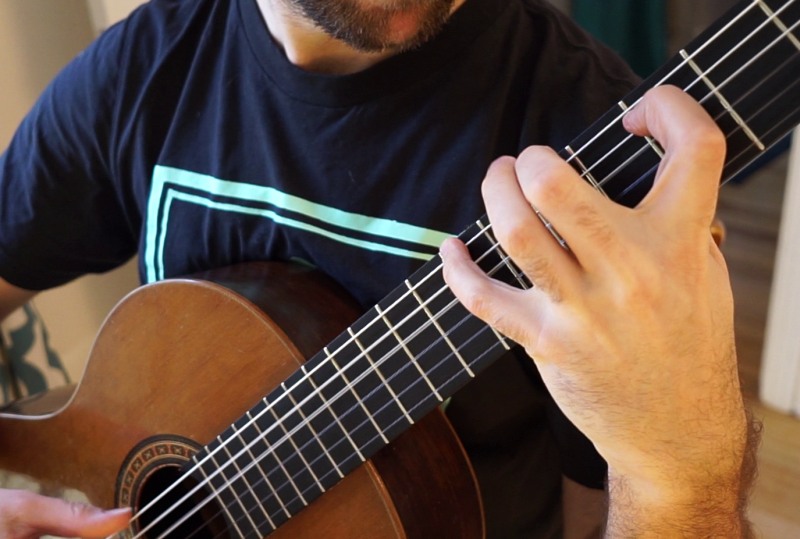Check out these awesome finger independence exercises based on scales in contrary motion - essential for fingerstyle guitarists!
You may be thinking that your playing sounds too stiff and the guitar feels awkward. You may find that your playing is not as smooth as you like.
That sucks!
Let's instead learn some exercises to develop your finger independence. We are going to learn how to place the fingers exactly where they will produce the best sound on the guitar.
Not only that, these exercises will force you to return to a neutral position after plucking each note.
What Are The Best Finger Independence Exercises for Guitar Playing?
The best way to improve finger independence and coordination between both the fretting and the plucking hand in guitar is to play scales in contrary motion.
In music, a scale is a series of notes arranged in a specific pattern of ascending or descending pitch. Scales are the foundation of melody and harmony in music, and are used to create musical phrases and chord progressions.
A scale in contrary motion, on the other hand, is a specific way of playing a scale where the two parts move in opposite directions.
For example, if you were to play a C major scale in contrary motion, you would start with the highest note of the scale being played on the first string and the thumb playing the lowest note of the scale on the sixth string.
Then, as you ascend the scale in the bass, the treble voice will descend the scale, playing each note in the opposite direction.
How To Develop Finger Independence for Guitar Playing
In order to play the guitar fluently instrument, your fretting hand must be efficient and relaxed.
When you play scales in this manner, you are forced to place the fingers exactly in the right spot on the fretboard. Pay attention to how your fingers must stretch differently, depending on which note you are playing in the scale pattern.
You should avoid re-adjusting the fingers after placing them on the fretboard. If proper finger placement is new to you, be sure to practice these exercises very slowly and watch your finger movement carefully.
The idea is that you make the sound perfect right off the bat, and you don't re-adjust the fingers after placing them on the guitar neck.

5 Incredible Finger Independence Exercises
To get the most out of these finger independence exercises, avoid playing them too fast, even if you are able to or you find it boring. Let's go!
1. C Major Contrary Motion Scale
Here's an example of how you could play the C Major scale in contrary motion on the guitar. The bottom notes are C, D, E, F, G, A, B, and C and the top notes are C, B, A, G, F, E, D, and C.
If you can't play the unisson, which involves a stretch from the fifth to the tenth frets, then just play one of the notes. The point is to warm up, not pop your tendons.

2. B Flat Major Contrary Motion
This version of the B flat major scale involves starting the upper voice from the third degree of the scale or mediant. This is to make the finger pattern more interesting and also creates fewer stretches.

3. G Minor Contrary Motion Scale
The relative minor of B flat major being G Minor, let's look at this contrary motion scale to develop our finger independence. You may notice the minor scale contains a mix of both the harmonic and melodic scales. I also included a secondary dominant (V of IV).

4. E Flat Major Contrary Motion Scale
In this contrary motion scale, I've started the bass note on the third degree of the scale, or the mediant. This makes for an interesting inversion when the upper voice passes below the lower voice.

5. C Minor Contrary Motion Scale
The relative minor of E flat major is C Minor, and here is the contrary motion scale for this key.

After you finish this exercise you can move on to another warm up, such as regular scales, or start playing a song.
The next step after learning these contrary motion exercises is to develop your ability to play songs, and that's what you'll learn in the course Play Fingerstyle Guitar Now!
Why Is It So Hard To Pluck With The Ring Finger?
It can be tempting to only finger pick the guitar using the thumb, index and middle fingers. But if you neglect playing with your ring finger, you will seriously hinder your ability to play advanced songs.
The ring finger typically has much less flexibility than the middle or ring fingers. The reason for this lies in the anatomy of the hand: the fingers are controlled by tendons which attach to a muscle in the forearm called the extensor digitorum.
How To Practice Ring Finger Independence
The method suggested by Howard Morgen in his book Concepts to practice the ring finger is to play repeated block chords with the other fingers and concentrate on plucking a melody note with the ring finger.
I think you may run into trouble with sound quality if you concentrate on making the ring finger note sound louder. Instead, one method to improve your plucking hand is to reduce the volume of the accompanying chords, and concentrate on making the melodic line more beautiful.
The ring finger is most useful when playing notes on the first string. Because it's the closest to the bottom of the guitar, you can sometimes use this finger to play repeated notes on the first string.



